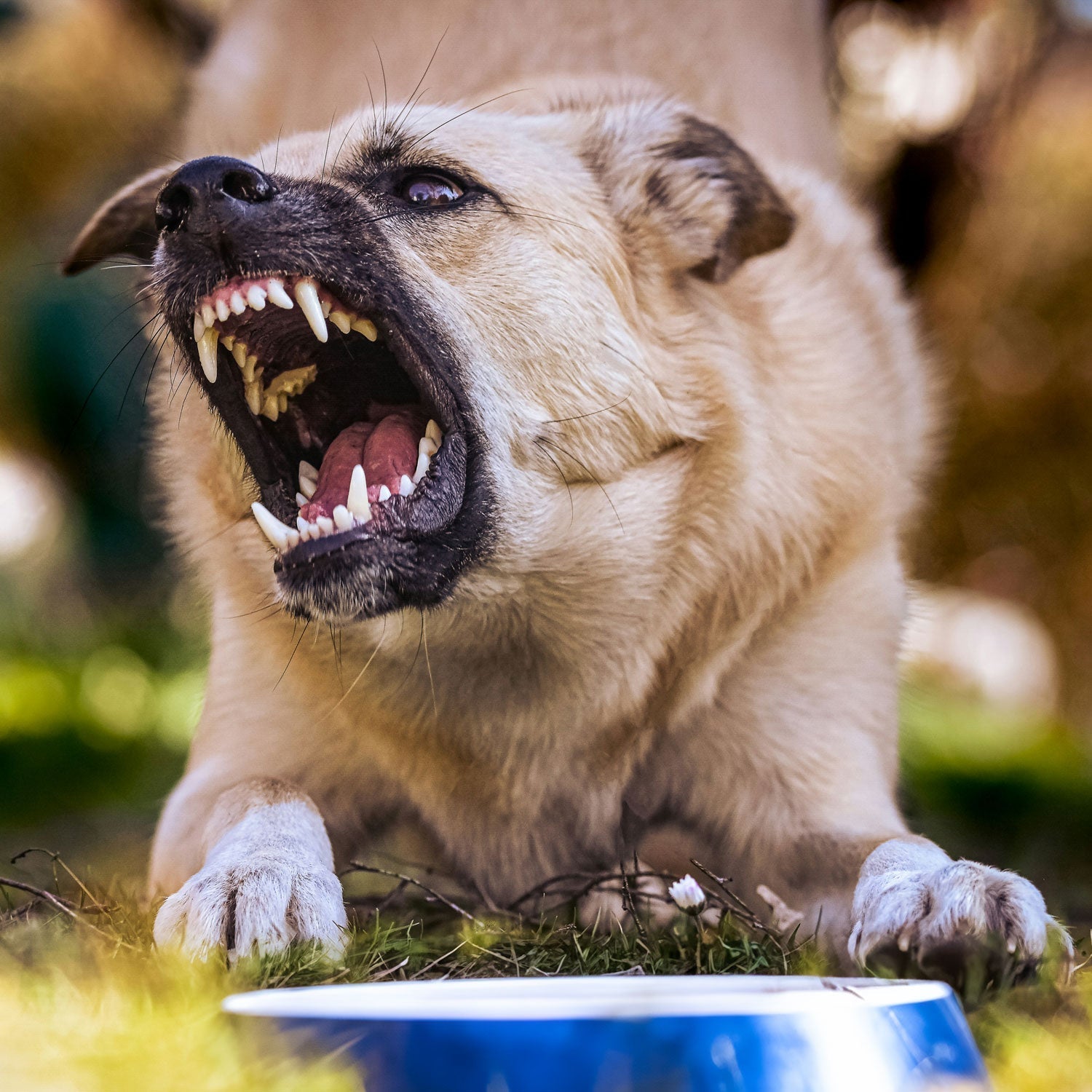Effective Solutions for Food Aggression in Dogs

Food aggression in dog behavior is seen when a dog growls, snarls, or even bites to protect their food. This article covers how to recognize the signs of food aggression in your Companion, understand the causes, and use techniques like positive reinforcement and safe feeding areas to manage this behavior.
Key Takeaways
-
Food aggression is driven by instinctual behaviors, past experiences, and environmental stressors, and understanding these factors is crucial for management.
-
Recognizing early signs of food aggression, such as growling and defensive body language, enables proactive handling to prevent the behavior from escalating.
-
Effective management strategies include positive reinforcement, creating safe feeding environments, and utilizing puzzle feeders, while severe cases may require professional intervention.
Understanding Food Aggression in Dogs
Food aggression is a behavior where dogs aggressively defend their food from perceived threats. This aggressive behavior can manifest in various ways, such as:
-
growling
-
snarling
-
Biting when someone approaches their food bowl. Understanding the underlying causes of dog food aggression is critical for controlling and resolving the reactions.
These causes can be broadly categorized into instinctual behavior, past experiences, and environmental stressors.
Instinctual Behavior
Food aggression in dogs is primarily driven by instincts related to resource guarding. In the wild, successfully protecting resources like food improves the chances of survival. This instinctual habit is deeply ingrained in most dogs and can be influenced by genetics, although it is not the only contributing factor. For instance, early exposure of puppies to various social situations can lead to healthier eating habits and reduce potential guarding behaviors in a food-aggressive dog.
Guarding behavior can also indicate fear or anxiety, especially in lower-status dogs. Eating before dogs reinforces a human’s status as the pack leader, which can help reduce aggressive traits.
Resource guarding can be particularly dangerous in home environments where children, who may not understand dog behavior, are present. Recognizing these natural instincts enables pet parents to effectively manage and mitigate aggressive behavior in a resource-guarding dog while respecting personal space.
Past Experiences
Past experiences, such as hunger or competition for food, can significantly increase the likelihood of this agressive disposition. Dogs that have experienced neglect or abusive situations may develop food guarding habits as a learned response to protect their valuable resources.
Professional trainers can help identify and address the root causes of aggression, offering expert assistance to manage and mitigate this behavior.
Environmental Stressors
Environmental stressors, such as fear or anxiety around mealtime, can also contribute to this meal time aggression . Dogs that feel threatened or anxious are more likely to become territorial and hostile over their food. Spotting subtle signs of discomfort early is essential for managing aggressive behavior effectively.
A calm and stress-free feeding environment can alleviate feelings of threat and anxiety.
Recognizing Signs of Food Aggression in Dogs
Early recognition of food possessiveness signs is key to successful management and resolution. This can manifest in various ways, ranging from growling to more aggressive behaviors like biting. Recognizing these signs enables "pet owners" to take proactive steps to manage aggression before it escalates. Common signs of aggression include growling, snarling, defensive body language, and rapid eating.
Growling and Snarling
Growling and snarling are the initial warning signs of aggression. These behaviors indicate that a dog is feeling threatened and is ready to defend its food. Other warning signs during mealtime may include lunging or biting.
Early recognition of these warning showing signs helps prevent escalation into more severe aggression that can jeopadrize your own Companions health.
Defensive Body Language
Defensive body language in dogs can manifest during mealtime, as they often feel protective of their food. Signs such as a lowered head and stiff body posture often signify a dog’s dish unease as an approaching person nears its food dish.
Identifying these signs helps dog owners proactively manage aggression and maintain a safe feeding environment.
Rapid Eating
Rapid eating in dogs can indicate a behavioral response to perceived threats. If a dog eats its food quickly, it may be an attempt to guard its food from potential threats. This behavior often arises from a dog’s instinct to prevent others from accessing their meal.
Recognizing rapid eating is one of the pillars for identifying aggression and implementing effective behavior management strategies before escalating the situation.
Managing Food Aggression in Dogs
A combination of strategies such as Praise-based training, establishing safe feeding areas, and using puzzle feeders and toys is required to manage food aggression in dogs. These methods can help reduce anxiety and create a positive feeding environment, making mealtimes more enjoyable for both dogs and their family.
Positive Reinforcement Techniques
Using Praise-based training builds trust and fosters a sense of safety around food. Training a dog to sit and wait before food is given can help encourage sharing behavior. Tossing a treat near a dog’s bowl can shift their perception, showing that human presence is positive. Before feeding, have the dog sit or lie down outside the feeding room to create a calm environment.
Observe that the dog begins to relax while eating before moving to the next train stage. Involving other adults in the training reinforces the lessons learned. Initially, stand a few feet away while the dog eats, and gradually increase the distance as trust builds.
Never scold a dog when addressing food aggression, as it can increase anxiety and aggression. Taking away the dog’s food bowl as punishment should be avoided, as it can escalate aggressive behavior.
Establishing Safe Feeding Areas
To minimize stress during feeding, consider the following:
-
Choose a quiet area where dogs won’t feel crowded.
-
Provide a quiet feeding environment to help dogs focus on their food without feeling scared.
-
Feed dogs at set times to create a routine and lessen anxiety.
Distractions during mealtime can induce feelings of fear or protectiveness in dogs.
Using Puzzle Feeders and Toys
Puzzle feeders are designed to slow down a dog’s eating pace and can also reduce aggression. These feeders reduce anxiety while providing necessary mental stimulation that can minimize aggressive habits.
Food-dispensing toys mentally engage dogs, slow the feeding pace, and redirect their attention away from guarding behavior.
Training Methods to Reduce Food Aggression
Methods like teaching the “leave it” command, using desensitization exercises, and hand feeding can effectively reduce possessive behaviours in dogs and help stop food aggression. These methods help build trust, reduce anxiety, and create positive associations with food and human presence.
Teaching The “Leave It” Command
The “leave it” command serves as a useful tool to lower Food possessiveness in dogs. Practicing the “leave it” command with non-food items like toys, or anything that might awaken your companions' interest during a walk, is essential before introducing it in food scenarios. This command helps dogs learn to control their impulses and can reduce aggressive tendencies during mealtimes.
Desensitization Exercises
Desensitization involves:
-
Gradually exposing the dog to triggers, starting with an approach while eating and offering treats.
-
Introducing food triggers gradually to improve comfort levels.
-
Gradually moving closer while rewarding relaxed behavior is effective for desensitization.
Desensitization aims to make the dog feel relaxed around food and human presence without aggression.
Hand Feeding
Hand feeding small pieces of food can effectively reinforce trust between you and your dog. Follow these steps:
-
Begin by giving treats from your hand.
-
Gradually decrease the distance to the dog’s bowl.
-
Lift the dog’s bowl slightly while adding a treat to encourage positive behavior. Additionally, you can hand-feed the dog to strengthen this bond.
If a dog waits too long for food while following cues, it can lead to increased frustration and potential aggression, affecting the dog’s behavior so be aware that it takes time and patience.
Preventing Food Aggression in Puppies
Preventing food aggression in puppies requires early intervention and the creation of positive mealtime experiences. Key strategies include:
-
Early socialization
-
A consistent feeding routine
-
Positive reinforcement during meals can help reduce the likelihood of food aggression in puppies.
Early Socialization
Early socialization enables dogs to interact comfortably with humans and other animals, reducing the likelihood of food aggression. It also reduces anxiety and stress, which can trigger aggressive reactions.
Implementing early socialization practices can significantly enhance a puppy’s future interactions and mitigate aggressive tendencies.
Consistent Feeding Routine
A predictable feeding schedule can foster a sense of security for puppies, lessening the likelihood of food aggression. A consistent feeding routine can significantly improve a dog’s behavior, especially when considering feeding times.
Knowing when to expect their meals reduces dogs’ anxiety and competitive instincts.
Positive Mealtime Experiences
Using treats during feeding can create a positive association, encouraging puppies to feel comfortable while eating. You can say ‘bonus’ or 'treat' as you toss tasty treats to a dog while it eats.
Make sure the puppy eats calmly and undisturbed to promote a positive mealtime experience. Subtle signs of discomfort should be observed during mealtime to identify any issues early.
When to Seek Professional Help
If a dog’s food aggression is extreme, seeking expert help is essential. Seek professional guidance if a dog is already exhibiting food bowl aggression. Contact a veterinary hospital for assessment and solutions if your dog shows signs of food aggression. This usually happens with dogs that have past experiences with neglect and sometimes even abuse ,its important to remember this when aboarding this topic and speaking with your vet about it as this provides insight on the causes of this conduct.
For a severe problem with food aggression, it is important to consult a professional for assistance.
Consulting a Certified Trainer
To manage severe food aggression in dogs:
-
Consult a certified dog trainer or behaviorist.
-
Obtain a customized plan from the professional.
-
Receive guidance through the training process.
-
Apply behavior modification techniques provided by the trainer.
For dogs with a history of biting, consulting a behavioral expert for tailored strategies is crucial for the dog’s well-being.
Veterinary Evaluation
New onset of food guarding behavior in dogs warrants a veterinary visit. Veterinary evaluations are necessary to rule out underlying medical issues contributing to aggressive behavior in dogs.
Summary
In summary, understanding the causes and signs of food aggression in dogs is crucial for effective management and prevention. By implementing positive reinforcement techniques, establishing safe feeding areas, and using puzzle feeders and toys, dog parents can create a harmonious feeding environment. Early socialization and consistent routines can prevent food aggression in puppies. If food aggression persists, seeking professional help is essential. Remember, a calm and positive approach is key to managing food aggression in dogs, paired with insights into a dog's past if adopted or rescued.
Frequently Asked Questions
What is food aggression in dogs?
Food aggression in dogs is a behavior characterized by the dog aggressively defending its food from perceived threats, which can include growling, snarling, or biting. Addressing this behavior is important to ensure a safe environment for both the dog and those around it.
How can I recognize signs of food aggression in my dog?
To recognize signs of food aggression in your dog, look for growling, snarling, defensive body language, and fast eating. Addressing these behaviors promptly is crucial for a harmonious environment.
What are some effective ways to manage food aggression in dogs?
To effectively manage food aggression in dogs, utilize positive reinforcement techniques, create safe feeding areas, and introduce puzzle feeders or toys. These strategies help promote a calm and secure eating environment.
How can I prevent food aggression in my puppy?
To prevent food aggression in your puppy, focus on early socialization, establish a consistent feeding routine, and use positive reinforcement during mealtime. These strategies will foster a calm and positive relationship with food.
When should I seek professional help for my dog's food aggression?
If your dog's food aggression is severe or poses a risk of biting, it's essential to seek professional help promptly. Engaging a certified trainer or veterinarian can provide the necessary guidance and intervention.
Subscribe
Sign up to get the latest on sales, new releases and more…
Categories
- Best Places to Take Your Dog on Vacation this 2026(USA Edition)
- Tails of Celebration: Working Dogs of the Lares Trek, A Silent Partnership In Peru
- 5 Easy Organic Christmas Recipes for Dogs: Simple Holiday Treats Your Companion Will Love
- The 6 Best Luxury Gifts for Your Dog This Christmas: Thoughtful Holiday Comfort That Truly Lasts
- Why Playtime Matters: The Benefits of Mental Stimulation and Playtime with Your Companion
- Tails of Celebration: The Miao Dog-Carrying Festival - A Hero's Honor in China
- A Dog-Friendly Thanksgiving 2025: Comfort, Calm, and Easy Treat Recipes
- The Best Dog Beds for Winter 2025: 5 Luxury Styles for Warmth, Comfort & Orthopedic Support
- Tails of Celebration: The Feast of Saint Hubert — Belgium's Timeless Blessing
- Halloween Safety Tips for Dogs: How to Keep Your Companion Safe This Spooky season
- Tails of Celebration: Día de los Muertos / Day of the Dead for Pets, A Festival of Memory in Mexico
- How to Care for Senior Dogs in Fall: Mobility Tips & Joint Support
- Tails of Celebration: Kukur Tihar & The Tihar Festival of Nepal
- What is a VDI Testing for dogs ? : Insights, Procedures and Preventive Measures
- Cheap Dog Beds vs. Luxury Dog Beds: The Real Cost of a $50 "Disposable" Dog Bed
- Can Dogs Have OCD? Understanding Canine Compulsive Behaviors (CCD)
- Does My Dog Like Music? Find Out What Tunes Make Your Pup Wag!
- Effective Solutions for Food Aggression in Dogs
- 7 Frozen Treats Your Dog Will Love This Summer☀️🧊🍉
- The Best Waterproof Liners for Dog Beds: Protect Against Spills, Drool, and Accidents
- How to Cope with the Loss of a Dog: A Tribute to Every Companion We Carry in Our Hearts
- Top Tips on How to Prevent Matting in Dogs
- Understanding and Managing Dogs with Hip Dysplasia
- The Ultimate Guide to Dog Gut Health: Natural Remedies, Probiotic Insights and Signs of Poor Gut Health
- The Best Supplements for Dogs: Explore Top Picks for Canine Health and Wellness
- How Often Should I Brush My Dog's Teeth? Tips for Optimal Canine Dental Health
- Ultimate Guide on How to Comfort Your Dog During Fireworks this 4th of July
- Managing a Blowing Coat: Essential Grooming Tips for Double-Coated Dogs.
- 5 Daily Habits That Boost Your Dog’s Long-Term Wellness
- Mastering Crate Training a Dog: Tips and Benefits
- Dog Car Seats vs. Seat Covers: What’s The Best Option For Your Companion?
- Best Outdoor Dog Beds: Luxury, Durability, and Unmatched Comfort
- Is My Dog Overweight? Tips to Assess and Help Your Companion
- The Best Faux Fur Dog Beds for Ultimate Pet Comfort of 2025
- Dog Running Guide: How to Start, Train & Stay Safe when running with your Dog
- Indestructible Dog Beds? The Truth Behind the Term
- Top Tips for Effective Exercise for Dogs
- Effective Dog Ear Cleaning: A Step-by-Step Guide for Maintaining Healthy Ears
- How to Manage Dog Aggressive Behaviors: Expert Tips and Advice
- Effective Canine Ear Infection Remedies: Symptoms, Causes & Treatments
- How to Make a New Dog Comfortable in Their New Home - 2025 Guide
- Signs of Dog Allergy Symptoms and How to Help and Prevent Them
- Why Does My Dog Lick Their Paws? Causes and Solutions Explained
- Dog Alzheimer's: Symptoms, Causes, and Treatment Options
- The Legacy of Comfort with the Iconic Animals Matter® Ortho Companion-Pedic® Puff Luxury Dog Bed
- Orthopedic Square Dog Beds: The Ultimate Blend of Luxury, Comfort, and Support
- Loungers: The Ultimate Beds for Luxury, Comfort, and Orthopedic Support
- Square Dog Beds: Orthopedic Comfort and Stylish Designs for Your Companion
- Effective Solutions for Canine Incontinence: Identifying Causes and Best Treatments
- Ethical, Sustainable, and Certified: Why Certified Products Matter, Exploring CA Prop 65 and CertiPUR-US® Standards







Leave a comment
Please note, comments must be approved before they are published